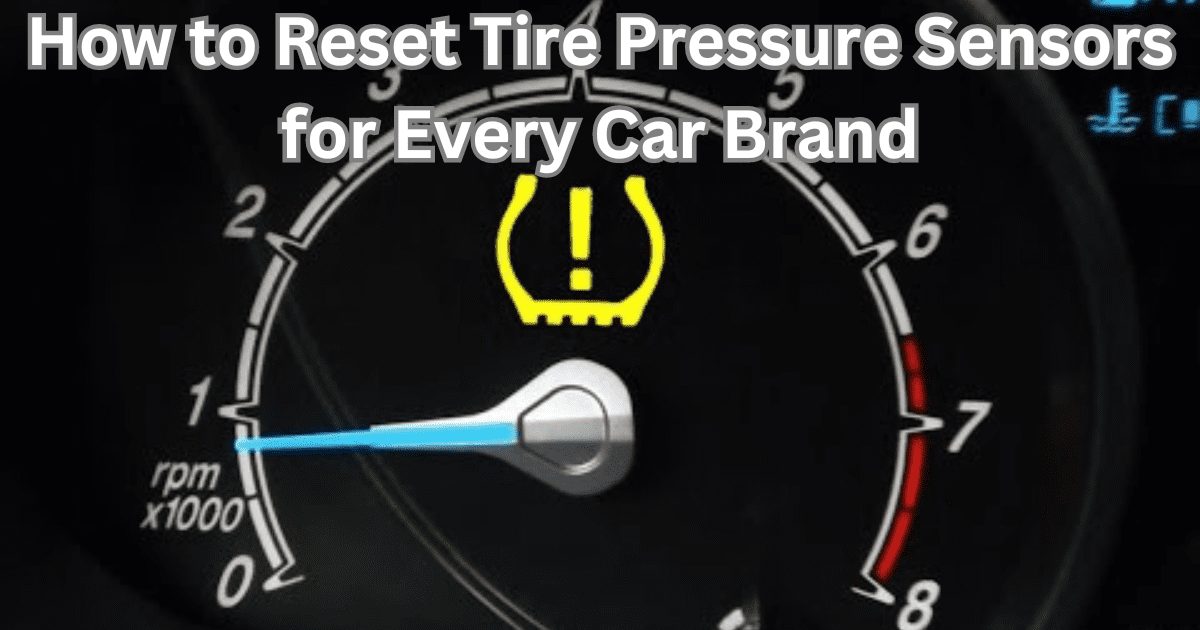Have you ever had that annoying light on your dashboard tell you to check your tyre pressure? The Tyre Pressure Monitoring System (TPMS) in your car is made up of a network of sensors that check the air pressure in your tyres all the time. What if the light comes on even after you use the right amount of air in your tyres? A simple restart is enough sometimes.
This piece teaches you about tyre pressure sensors (TPMS), how to reset them on different car models, and how to make sure your tyres are properly inflated for safety and performance.
What is a Tire Pressure Sensor?
A TPMS sensor, or tyre pressure sensor, is a small electronic device that is put inside each tyre to check the air pressure. Its main job is to let drivers know when their tyre pressure is too low or too high, which helps keep them safe and keeps their tyres from wearing out.

Most tyre pressure sensors are connected to the valve stem or wheel rim inside the tyre. On some cars, sensors may be mounted on the wheel well or axle from the outside.
How TPMS Works

Inside the sensor is where the magic happens. A part that is sensitive to changes in air pressure does something. The monitor tells the car’s computer about changes in the pressure by sending a signal. The computer then figures out what the information means and either shows you the tyre pressure on the dashboard or lets you know if it drops below the level that is suggested.
Symptoms of a Faulty Tire Pressure Sensor:
Even these watchful guards can break down. Keep an eye out for these signs:

- The most clear sign is an illuminated TPMS light.
- Readings That Aren’t Accurate: The pressure shown on the screen might not match the pressure in your tyres.
- Flat Tyre Warning Even Though Tyres Are Fully Inflated: If the light stays on after you’ve inflated your tyres, the monitor may be broken.
Checking and Adjusting Tire Pressure
It is very important to keep the right tyre pressure. To set it up and test it, follow these steps:

- The owner’s instructions for your car will tell you what tyre pressure is best for your car.
- Before you drive, use a reliable tyre pressure gauge to check the pressure in each tyre when they are cold.
- To get the tyres to the right pressure, pump them up or down as needed.
- After adjusting the pressure, reset the TPMS (explained in more depth below) to get rid of any warnings.
Resetting the TPMS Light: Brand-Specific How-To

It’s time to start over! Here is a list of some well-known car brands:
- Toyota: Park the car and turn it off. Then, press and hold the TPMS reset button, which is usually next to the steering wheel, for about 6 seconds. The TPMS light should blink twice to show that the reset was successful.
- Nissan: For specific directions on how to reset the TPMS, check your owner’s manual. Some Nissan models need to be scanned with a special tool.
- Finding the TPMS reset button is similar to Toyota: press it with the car in “accessory mode” (engine off, but electronics on) and the TPMS light blinking quickly to confirm a reset.
- Mazda: Put your car in park with the engine off and the hazard lights on. Then, use the controls on the steering wheel to move through the menus in the instrument cluster until you find the “TPMS reset” choice. Just do what it says on the screen to finish the reset.
- Ford: Ford does things in a different way. Go faster than 50 mph for at least 20 minutes. If the problem is only a small change in pressure, the system will figure out the right pressure on its own and turn off the TPMS light.
Keep in mind that these are just general rules. The best and most up-to-date information on how to reset the TPMS on your individual model of car can always be found in the owner’s manual.
Different Types of Tire Pressure Sensors:
There are two main kinds of sensors that check tyre pressure:
- Direct TPMS: This system has sensors in each wheel that send the exact reading of the tyre pressure to the car’s computer.
- Indirect TPMS: This system checks the speed of the wheels by using sensors from the ABS (Anti-lock Braking System). If a deflated tyre with a smaller width is found to have low pressure, the TPMS light will come on.
Replacing and Buying:
When you replace your tyre pressure sensors, make sure they work with the make and type of your car. You can find a wide range of TPMS sensors at reasonable prices at reputable auto parts shops or online stores like Auto Veteran.




